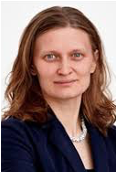Dr. Tatjana Tchumatchenko
 Independent research group leader at the MPI for Brain Research, Frankfurt am Main, Germany. Head of the group “Theory of Neural Dynamics”
Independent research group leader at the MPI for Brain Research, Frankfurt am Main, Germany. Head of the group “Theory of Neural Dynamics”
Research Positions
Faculty member at the IMPRS Graduate School for Neural Circuits
Postdoctoral fellow at Columbia University
Postdoctoral fellow at the Center for Theoretical Neuroscience, Colombia University, New York, USA
PhD Student at the Max Planck Institute for Dynamics and Self-Organization and the University of Göttingen
Honors and Awards
Focus selects Tatjana Tchumatchenko as one of 25 young innovators who will shape Germany’s future.
Three year grant of DFG Computational Connectomics priority program
PI in the DFG CRC1080 network ”Explorative Computational Approaches in Molecular and Cellular Mechanisms of Homeostasis”
Dollwet Foundation Award
Heinz Maier-Leibnitz-Prize of the German Research Foundation, one of the most prestigious prizes for young researchers in Germany
Dollwet Foundation Award
Mentorship Travel Grant for the Computational and Systems Neuroscience conference, jointly with my PhD student Sara Konrad
Grant of the CRC1080 network “Explorative Computational Approaches in Molecular and Cellular Mechanisms of Homeostasis”
PhD graduation rights awarded by the Computer science and mathematics department at Goethe-University, Frankfurt am Main
Fellowship at the Interdisciplinary Center for Neuroscience, Frankfurt am Main
Behrens-Weise-Foundation Award
”AcademiaNet excellence” membership, upon nomination by the Volkswagen Foundation
Best Poster Award, Computational Neuroscience Meeting CNS*2009
Sloan Swartz Travel Grant 2009
Five Travel grants awarded by the Göttingen Graduate School
Fellowship at German National Merit Foundation (Studienstiftung des deutschen Volkes)
Selected papers
1. How mRNA localization and protein synthesis sites influence dendritic protein distribution and dynamics. Fonkeu Y, Kraynuykova N, Hafner A-S, Sartori F, Schuman EM, Tchumatchenko T. NEURON 2019, doi: 10.1016/j.neuron.2019.06.022.
2. Stabilized supralinear network can give rise to bistable, oscillatory and persistent activity. Kraynyukova N, Tchumatchenko T. PNAS 2018, 201700080.
3. How linear response shaped models of neural circuits and the quest for alternative. Herfurth T, Tchumatchenko T. Curr Opin Neurobiol 2017, 6, 234-240.
4. Pairwise spike correlations fully capture the information content of a neuron. Dettner A, Muenzberg S, Tchumatchenko T. Nature Communcations 2016, 7, 13805.
5. Synaptic unreliability facilitates information transmission in balanced cortical populations. Gatys LA, Ecker AS, Tchumatchenko T, Bethge M. Phys Rev E 2015, 91, 062707.
6. Oscillations emerging from noise-driven steady state in networks with electrical synapses and subthreshold resonance. Tchumatchenko T, Clopath C. Nature Communications 2014, 5, 5512.
7. A cochlear-bone wave can yield hearing sensation as well as otoacoustic emission. Tchumatchenko T, Reichenbach T. Nature Communications 2014, 5, 4160.
8. Ultrafast Population Encoding by Cortical Neurons. T. Tchumatchenko, A. Malyshev, F. Wolf and M. Volgushev. J Neurosci 2011, 31 (34) 12171-12179.
9. Delivery of time-varying stimuli using ChR2. Tchumatchenko T, Newman JP, Fong M-F, Potter S. Front Neural Circuits 2013, 7:184.
10. Correlations and synchrony in threshold neuron models. T. Tchumatchenko, A. Malyshev, T. Geisel, M. Volgushev and F. Wolf. Phys Rev Lett 2010, 104 (5), 058102.
